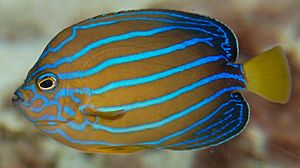Blue-striped angelfish facts for kids
The blue-striped angelfish (Chaetodontoplus septentrionalis) is a beautiful fish that lives in the ocean. It is also called the bluelined angelfish. This fish is a type of marine angelfish and belongs to a group called Pomacanthidae. You can find it swimming in the western Pacific Ocean.
Quick facts for kids Blue-striped angelfish |
|
|---|---|
 |
|
| Conservation status | |
| Scientific classification | |
| Synonyms | |
|
Holacanthus septentrionalis Temminck & Schlegel, 1844 |
Contents
What Does It Look Like?
The blue-striped angelfish has a bright body. It can be yellow or tan. It has cool, bright blue stripes all over it. Its tail fin is also yellow.
Males, Females, and Young Fish
Female angelfish have blue stripes that run all the way along their bodies. Male angelfish have duller stripes on their bodies. They also have blue lines on their faces.
Young angelfish look different! They are black with yellow spots on their fins. They also have a yellow bar behind their heads.
Where Do They Live?
You can find the blue-striped angelfish in the western Pacific Ocean. They live near countries like southern Japan, South Korea, Taiwan, and southern China.
Home and Habits
Blue-striped angelfish love rocky reefs. These reefs have big rocks and stones. They also like slopes made of rubble. You can find them in water from about 2 to 30 meters deep. That's about 6 to 100 feet!
Young angelfish often live in deeper water. They prefer depths from 15 to 30 meters. They stay close to cracks in the rocks. This gives them a safe place to hide if they need to.
What Do They Eat?
These angelfish enjoy eating sponges and tunicates. Tunicates are small sea animals.
How They Grow
Like many other angelfish, the blue-striped angelfish is a protogynous hermaphrodite. This is a fancy way of saying that all of them start out as females. Then, the strongest or most dominant females can change into males later in life.
As a Pet
Sometimes, the blue-striped angelfish is sold for aquariums. It's not super common to find them. But when they are kept in tanks, they often do very well!


